This post may contain affiliate links. If you click and buy, we may earn a small commission at no extra cost to you. Learn more.
Rustic kitchen design is becoming popular in American homes. It brings warmth and timeless beauty. This guide will show you how to make any kitchen cozy and rustic in just five steps. You’ll learn to mix rustic charm with everyday use.
Find out how to pick natural materials and the right colors. Also, learn about fixtures that show off rustic style. Each step makes creating a welcoming and practical kitchen easy. This guide works for any budget or space, making your rustic kitchen a place you’ll cherish for years.
Contents
- 1 What is a Rustic Kitchen?
- 2 Benefits of a Rustic Kitchen
- 3 Choosing the Right Color Palette
- 4 Selecting Rustic Materials
- 5 Furniture and Fixtures for Your Rustic Kitchen
- 6 Lighting Ideas for a Rustic Kitchen
- 7 Incorporating Old-World Charm
- 8 Tips for a Functional Rustic Layout
- 9 Personalizing Your Rustic Kitchen
- 10 Maintaining Your Rustic Kitchen
What is a Rustic Kitchen?
A rustic kitchen is more than a space; it’s a vibe. It’s cozy, welcoming, and connected to nature. This style mixes practicality with a laid-back, natural charm that feels like home. Whether you love farmhouse style kitchen simplicity or a mountain cabin look, rustic design is all about being real.
Defining the Rustic Aesthetic
Rustic kitchens draw from rural life, using materials like wood, stone, and iron. They celebrate imperfections, like weathered wood beams or faded paint. It’s not about being perfect; it’s about telling a story.
“The best rustic spaces feel lived-in, like they’ve evolved over time.” — Interior Design Magazine
Key Elements of Rustic Design
- Materials: Reclaimed wood, stone countertops, or copper accents.
- Colors: Earthy tones like terracotta, muted greens, or warm grays.
- Textures: Rough-hewn timbers, natural stone, or woven baskets.
- Lighting: Exposed light fixtures, like iron chandeliers or oil-rubbed sconces.
These elements come together to make a space that’s both useful and full of soul. Whether it’s a farmhouse style kitchen with a hutch or a lodge-inspired area with plaid, the aim is to blend beauty with function.
Benefits of a Rustic Kitchen
Rustic kitchens are not just stylish; they also make daily life better. They mix comfort with beauty. Ideas from rustic design help families for generations.
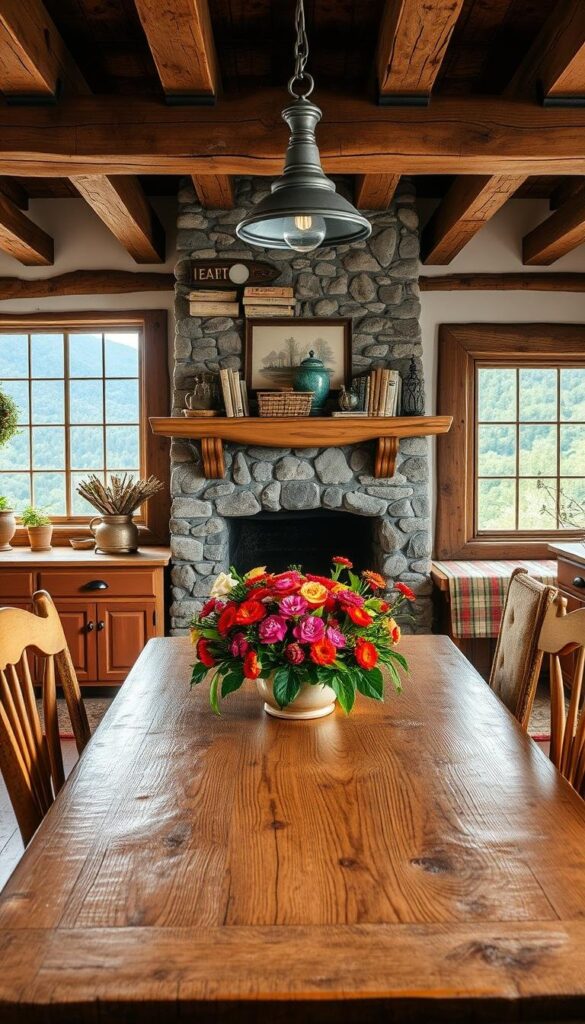
Warmth and Comfort
Wooden beams and stone add warmth to these kitchens. Soft lighting and textured fabrics make them cozy. The look of unfinished edges and organic shapes makes them feel like home.
Timeless Appeal
“Rustic design avoids fleeting trends by celebrating enduring craftsmanship.”
Rustic kitchens stay stylish over time. They use earthy tones and classic materials. This makes them a good choice for home improvement.
Eco-Friendly Features
- Reclaimed wood countertops reduce waste and add charm.
- Locally sourced timber supports sustainability and local traditions.
- Natural ventilation and energy-efficient appliances are good for the planet.
These features make rustic kitchens stylish and eco-friendly.
Choosing the Right Color Palette
Creating a cohesive rustic kitchen starts with selecting colors that echo nature’s palette.
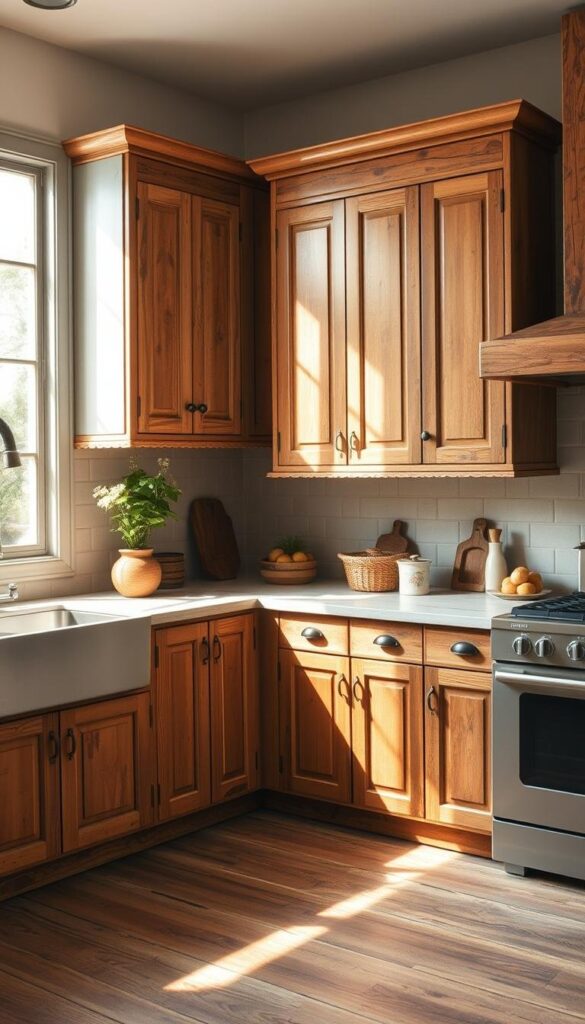
Warm neutrals and muted tones ground the space in earth’s simplicity. Let’s explore how to blend foundational hues with strategic accents.
Earthy Tones
Think of your walls and large surfaces as a canvas for rustic kitchen cabinets to shine. Opt for warm browns like chestnut or taupe, which mimic tree bark and soil. Soft tans and muted greens add a subtle freshness. These colors act as a neutral backdrop, letting rustic textures take center stage.
- Browns: Rich, unpolished wood tones
- Tans: Creamy hues for walls or countertops
- Greens: Muted sage for calming contrast
Accent Colors
Small splashes of color keep the space lively without disrupting the rustic vibe. Try cobalt blue mugs or terracotta planters. Farmhouse aprons or woven baskets in mustard or deep red add warmth. Mix and match these accents seasonally for fresh looks without overhauling the design.
“Rustic kitchens thrive on balance—bold accents should feel like a whisper, not a shout.”
Choosing Cabinet Colors
Rustic kitchen cabinets set the room’s mood. Distressed white pairs well with dark wood floors. Natural wood stains highlight grain patterns, while muted sage or burnt orange cabinets add unexpected depth. Pair light upper cabinets with darker lowers to create visual weight.
Selecting Rustic Materials
Creating a rustic kitchen means choosing materials that are both functional and stylish. The right picks bring warmth and a genuine feel without costing too much. Let’s dive into the key elements that make this look timeless.
Wood Options for Countertops
Countertops made from reclaimed pine or oak instantly add charm. For lasting durability, think about butcher block maple or teak, which resist stains well. Brands like Wilsonart offer affordable, prefinished options that look like real wood. Remember, a sealed finish helps protect against moisture.

Stone Backsplashes
- Slate: It’s non-porous and heat-resistant, perfect for busy spots.
- Travertine: Its textured look adds depth; seal it yearly to keep oil out.
- River Rock: The clustered stones make a striking feature behind stoves.
Places like Home Depot sell these for $10–$40 per square foot, based on the type.
Metal Fixtures
Copper accents get better with age, while wrought iron faucets and racks bring an industrial vibe. For affordable choices, Delta and Restoration Hardware have polished brass handles under $25. Mixing metals like bronze and steel creates a rich look.
Choose materials wisely to avoid a cluttered look. Mix big, chunky wood with smooth metal for contrast. Focus on durability in busy areas and save delicate textures for decorative touches.
Furniture and Fixtures for Your Rustic Kitchen
Choosing the right furniture and fixtures makes a rustic kitchen come alive. Each piece should be both practical and warm, reflecting farmhouse style traditions. Let’s find the perfect balance between rustic charm and modern needs.
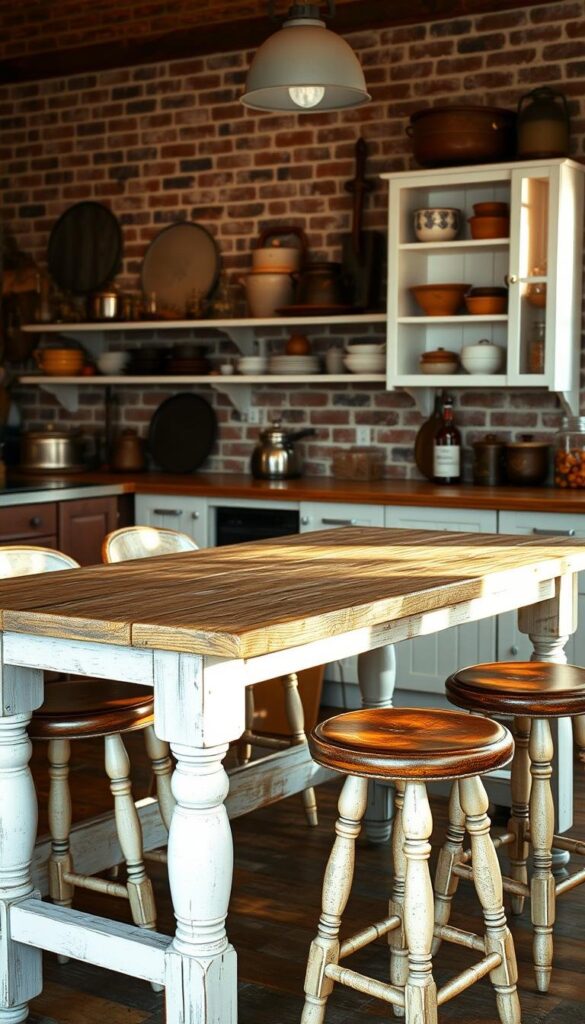
Farmhouse Tables
Start with a farmhouse table made from reclaimed pine or oak. Choose trestle or turned-leg bases for that rustic look. A weathered finish or live-edge tabletop adds real charm.
Brands like Restoration Hardware have pre-styled options. Etsy has unique finds. These tables are perfect for open layouts, making your kitchen a place for gatherings.
Vintage Stools
Vintage kitchen decor comes alive with unique stools. Look for ones with leather straps, cast-iron accents, or painted wood seats. Thrift stores or Wayfair’s vintage collections have timeless pieces.
Mix and match stool heights to add interest. Bar stools for islands and shorter stools near counters work well together.
Cabinet Styles
Cabinets are key. Open shelving shows off special items like pottery or cookbooks. Beadboard-faced cabinets add a coastal-rustic touch.
Choose brushed nickel or antique brass hardware for contrast. Target has affordable rustic lines. Layering glass and solid doors adds depth without cluttering the space.
“The best rustic kitchens feel like they’ve evolved over time—not rushed into existence.” —Interior Design Blog, 2023
Pair these elements with durable, easy-to-clean finishes. A well-chosen farmhouse table or repurposed stools can transform your kitchen. Vintage kitchen decor details will make your space feel both historic and welcoming.
Lighting Ideas for a Rustic Kitchen
Lighting sets the mood and function of a modern rustic kitchen. It highlights textures and creates cozy spots. The right lights balance warmth and usefulness. Mix rustic materials with modern tech to improve your space.

“Great lighting in rustic spaces doesn’t just illuminate—it tells a story.” — Sarah Thompson, Interior Designer at CountryLiving Interiors
Pendant Lights as Statement Pieces
Place pendant lights above islands or tables to center the room. Choose from wrought-iron by Hunter Fan Co. or aged-brass by Delta. Use one big light or several small ones for different looks. Add woven rattan shades for texture.
Under-Cabinet Lighting
Use Philips Hue LED strips under cabinets for task lighting. They work well with rustic decor without being too harsh. Soft white lights and hidden fixtures keep the focus on your decor.
Letting in Natural Light
Big windows and skylights bring in lots of daylight. Hang linen or burlap curtains from West Elm to soften the light. Skylights add depth without making the space feel too busy.
Combine these ideas for layered lighting that’s both useful and cozy. Whether through lights or windows, the right lighting makes your kitchen welcoming and timeless.
Incorporating Old-World Charm
Adding vintage kitchen decor turns rustic spaces into stories of the past. Reclaimed materials and antique pieces add layers of history. They don’t lose their modern functionality. Each crack and patina has a story to tell, making each piece a conversation starter.
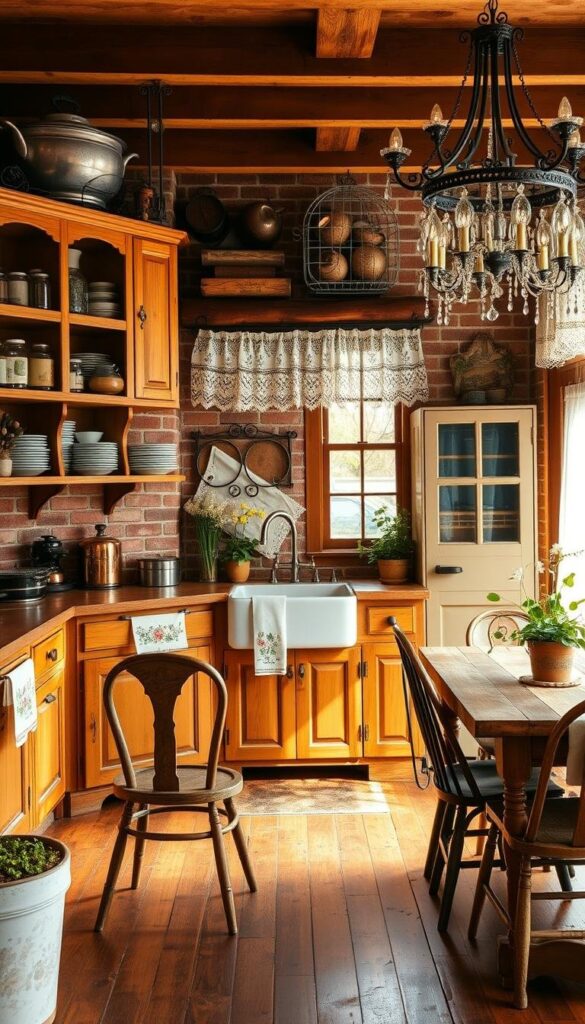
Reclaimed Materials
- Use salvaged barn wood for countertops or backsplashes.
- Repurpose weathered beams as dramatic ceiling accents.
- Opt for antique flooring like planks from old mills or factories.
Pair these finds with sleek appliances for a balance of nostalgia and practicality. Online marketplaces and local salvage yards have unique options for every budget.
Antique Accessories
Display heirloom pieces like copper pots or hand-thrown pottery on open shelves. Group small items like vintage canisters or scale replicas to avoid clutter. A well-placed 19th-century butter churn or hand-painted dish rack adds charm without overwhelming.
“Antiques are time capsules—let them breathe in modern settings.”
Combine mismatched vintage kitchen decor with neutral tones to highlight their uniqueness. Let weathered textures and faded finishes remind you that beauty comes from lived-in history.
Tips for a Functional Rustic Layout
Make your rustic kitchen both charming and practical. Choose smart designs that mix tradition with modern efficiency. This way, you keep the natural vibe intact.
Efficient Work Zones
Update the classic kitchen triangle for rustic spaces. Keep work areas open and connected. Use wide countertops and avoid cluttered corners.
A rustic kitchen island can be the centerpiece. It offers prep space and keeps the flow open.
Creating Open Spaces
Make your kitchen feel bigger with partial walls or arched openings. Large windows and light wood flooring help too. Choose furniture that’s slim and doesn’t clutter the space.
Practical Storage Solutions
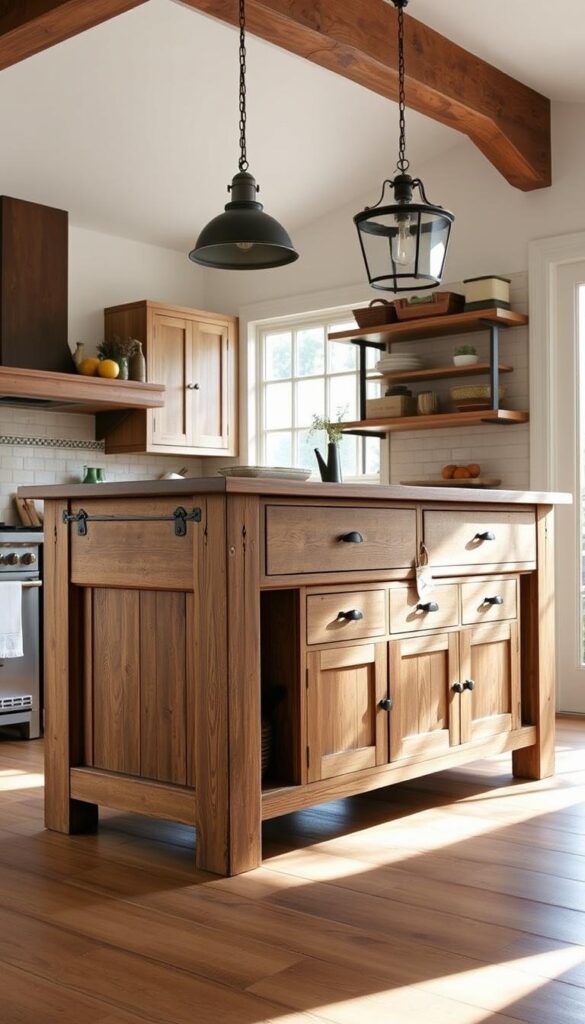
A rustic kitchen island can be a storage gem. Add built-in shelves or hanging pots. Use freestanding sideboards or old trunks for hidden storage.
Open shelving with woven baskets adds charm. It keeps essentials within reach.
- Use the island’s base for pot and pan storage.
- Hang utensils from exposed beams or hooks.
- Install slim, wall-mounted spice racks.
By mixing these tips, your kitchen will be both welcoming and organized. The right layout makes rustic style functional and beautiful.
Personalizing Your Rustic Kitchen
Every rustic kitchen has a story to tell. Make yours special with country kitchen ideas that show your personality. Small details and cherished items turn a design into a space that feels truly yours.
Adding Personal Touches
Begin with items that reflect your lifestyle. Show off vintage cookbooks on open shelves or hang locally woven baskets above a farmhouse table. Try:
- Handmade quilts draped over chairs
- Hand-painted signs with family recipes
- Regional pottery as countertop accents
These country kitchen ideas warm up the space without overwhelming it.
Showcasing Family Heirlooms
Make cherished items the stars of the show. Hang a great-grandparent’s rolling pin on the wall or use an old ladder as a pot rack. A weathered trunk can become seating near the breakfast nook. As one reader shared:
“My grandmother’s butter churn now holds spices—it connects every meal to her legacy.”
Personal touches like these turn your kitchen into a family history museum. Let heirlooms guide your choices so every corner has a story unique to your household.
Maintaining Your Rustic Kitchen
To keep your rustic kitchen looking great, you need to take care of it regularly. Whether you have rugged cabinets or modern touches, upkeep is key. Here are some tips to keep your kitchen stylish and functional.
Cleaning and Care Tips
Wooden cabinets need gentle cleaning. Use mild soap and a soft cloth to avoid damage. For sealed countertops, vinegar is better than harsh chemicals.
Wipe down metal fixtures weekly to stop tarnish. Dust exposed beams often to keep their natural look.
Seasonal Maintenance Ideas
Check stone or tile backsplashes twice a year for dirt. Reapply sealants to wooden countertops every 1–2 years. This keeps them moisture-resistant.
In modern rustic kitchens, look for cracks in hybrid materials like quartz-wood. Vacuum under appliances and check lighting for dust in spring and fall.
To bring you cozy inspiration more efficiently, we sometimes use AI to assist in content creation — but every word and idea is carefully shaped by our team. See our AI Disclosure for more info.







